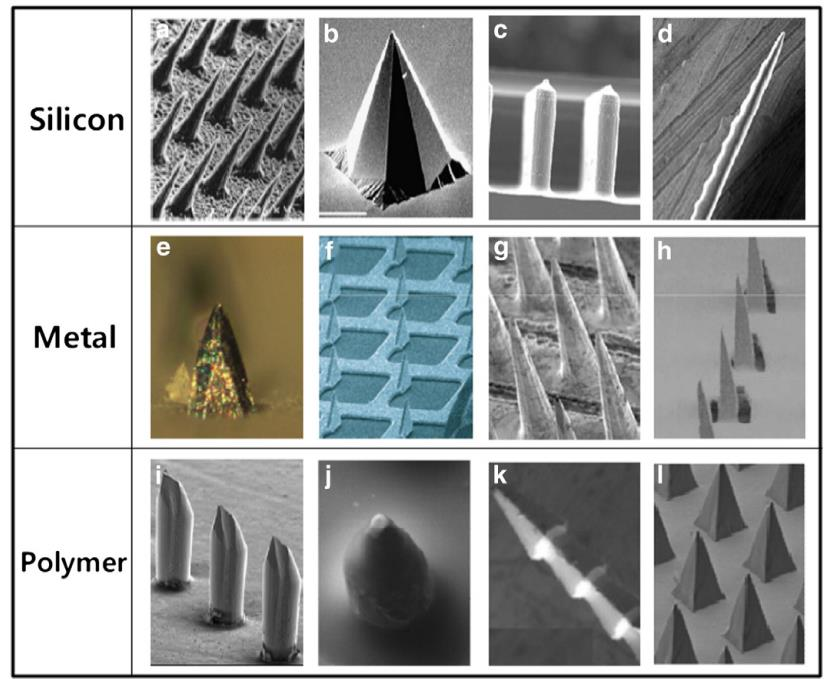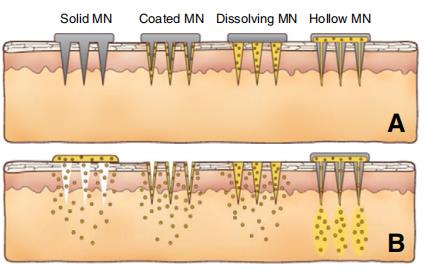Abstract
This thesis presents the research on the high solid silicon microneedles fabrication based on KOH anisotropic etching, aiming at finding a controllable way to fabricate 500 μm high microneedles with good height uniformity and tip sharpness. During this research, 200nm low-stress LPCVD SiNx is used as KOH etching mask; mask shape is squareshaped with its side along <100> direction of silicon wafer; wet etching is done in 29wt% KOH solution at 79℃.
In the introduction part, a general introduction of modern nanotechnology and microneedles is presented. The nanofabrication techniques that related to microneedles fabrication such as thin film deposition, photolithography, reactive ion etching, and KOH anisotropic etching are introduced for better comprehension of this research. In the experiments part, the fabrication process of microneedles is explained step by step, including SiNx deposition and patterning, KOH wet etching, isotropic reactive ion etching using SF6, and scanning electron microscope characterization. In the discussion part, the geometry of microneedles is studied by SEM characterization. The microneedle shape is determined as an octagonal pyramid, and its sidewall is determined as (311) plane. The aspect ratio of microneedle is 1.414. Then the growth model of microneedles in KOH etching is established. The maximum height of microneedle, obtained right after mask falling off, is positively proportional to its mask size; the real-time height of microneedle has a positive correlation during growth then, after mask falling off, a negative correlation during overetching with time. The height growth rate is 72.5 μm/h, while the height dropping rate during over-etching is 400 μm/h. Finally, an additional step of reactive ion etching by using SF6 gas is introduced following KOH etching before mask falling off to improve the uniformity of microneedles height, which also contributes to improve the tip sharpness. By replacing the inevitable over-etching using KOH with the SF6 RIE step, the standard deviation of microneedles height decreased from 20.50 μm to 11.12 μm; the tip apex diameter decreased from 6.92 μm to 2.71 μm.
1. Introduction
The introduction chapter briefly shows the concept and development of modern nanotechnology and nano/micro fabrication, and explain the principle of the microneedle fabrication process. Also, special techniques used in microneedle fabrication such as thin film deposition, lithography, reactive ion etching and silicon wet etching by KOH are introduced.
From last decade, the demand of IC product has been dramatically increasing. Thus, a top-down strategy that involves photo lithographic patterning techniques becomes more and more popular and mature for modern IC production. By using light source with decreasing wavelength, an exponentially decreased feature size of IC product is achieved in decades. Figure 1.1.2 shows the decreasing curve of technology node and wavelength of photo lithography light source over years. The light source plays an important role in photo lithography to determine the resolution of lithography. From 1980s, the lithography light source has been developed from ultra violet (UV) generated by mercury vapor lamp (gline=436nm, i-line=365nm) to deep UV generated by excimer laser (KrF=248nm, ArF=193nm, finally Extreme UV (EUV) generated by laser-pulsed tin plasma with wavelength of 13.5nm, which is considered the most powerful and advanced lithography light source in IC production. The miniaturization of IC related devices dramatically reduces the size, weight, and energy consuming of electronic devices, fundamentally supports modern internet technology and big data storage and analysis.

Figure 1.1.2 Scaling of the minimum feature size patterned by each successive semiconductor technology node, compared to scaling of the source wavelength (λ).
1.2 Introduction to microneedles
Microneedles are needle-shape structure fabricated by micro-nanofabrication method, typically with height from 100 μm to 1000 μm. Microneedles can be made from different materials and have different structures and functions depending on applications. Figure 1.2.1 shows a brief classification of microneedles. Based on the methods of functioning,microneedles can be classified as solid microneedles, coated microneedles, dissolving microneedles, hollow microneedles and so on. In recent years, microneedle is becoming more and more popular on needles market because of its convenience and low fabrication cost and its wide applications.
During a long time in the past, oral administration of drugs was considered as the most convenient drug delivery method. However, oral administration has insolvable drawbacks when facing the challenges from the digestive tract. Drugs based on protein, DNA, and other digestible compounds that can be digested are not suitable for oral administration. Moreover, oral administration takes a relatively long time to deliver drugs from mouth to blood, which may delay the treatment of drugs for time-urgent diseases. To solve the drawbacks of oral administration method, needle injection is also a popular method that can directly deliver drug into vivo. But due to the large size of the needle, disinfection process is usually needed to prevent infection on wound, and the patient also feels acute pain. Thus, there is a huge potential for microneedle patch to deliver drug by skin injection over other skin treatments. Figure 1.2.1 shows kinds of skin treatments. by adjusting the height of microneedles, penetrate epidermis can be penetrated to release drug without touching pain receptor. In recent years, applying microneedles patches on the skin becomes an attractive approach for the patients who are suffering painful injection via a hypodermic needle.


Figure 1.2.1 Images of types of microneedles. Images a~d are microneedles made from silicon; Images e~h are microneedles made from metal; Images i~l are microneedles made from polymers. A and B show the under-skin drug release process of microneedles that with different release methods.
Relationship between microneedles height versus mask size and etching time.
In order to control the microneedles height, a model that simulates the formation process of microneedles is necessary to predict the behavior of microneedles. The microneedles height is affected by many factors such as mask shape, mask size, etchant and its concentration, and etching temperature. In this experiment, mask shape, etchant and its concentration, as well as etching temperature are fixed. Thus, except of fixed parameters, the mask size can be chosen as variable to study the relationship between the microneedles height and mask size. Moreover, the etching is a dynamic process and the height of microneedles structure also depends on the etching time. By studying the relationship between real-time microneedles height versus etching time, the actual real-time microneedle height can be calculated based on etching time and mask size.
上一篇: 集成硅光子 MEMS
下一篇: 光刻技术和机器的发展